20 Best Onsen's in Japan: Famous Winter Hot Springs and More

Discover Japan's onsen hot springs. Find the best onsens for winter, tattoo-friendly and private baths, and mixed baths ideal for couples.
Open-air baths (rotenburo) are popular all year round but in winter, they make for a very special experience. Sitting in the hot water while snowflakes are falling on your head and cooling you down is extremely relaxing.
Let us introduce you to a selection of 20 hot spring resorts (onsen) in Japan with soothing waters and traditional townscapes. Should you visit Japan this winter, do give them a try. You'll understand right away why hot spring baths are so loved in Japan.
Top 20 Hot Spring Resorts in Japan
Famous Onsens Perfect for a Winter Escape
1. Noboribetsu Onsen (Hokkaido)
2. Ginzan Onsen (Yamagata)
3. Kusatsu Onsen (Gunma)
4. Manza Onsen (Gunma)
5. Shima Onsen (Gunma)
6. Shibu Onsen (Nagano)
7. Hakone (Kanagawa, near Mt. Fuji)
8. Atami Onsen (Shizuoka, near Tokyo)
9. Wakura Onsen (Ishikawa)
10. Kaga Onsen (Ishikawa)
11. Kinosaki Onsen (Hyogo, near Kyoto/Osaka)
12. Arima Onsen (Hyogo, near Kyoto/Osaka)
13. Dogo Onsen (Ehime)
14. Kurokawa Onsen (Kumamoto, near Fukuoka)
15. Beppu Onsen (Oita)
Tattoo Friendly Onsen's
16.Hisamatsuyu Onsen (Nerima)
17.Kosugiyu (Koenji)
Private Bath's
18.Zaborin (Niseko, Hokkaido)
19.Ubuya (Lake Kawaguchi, Yamanashi)
Hot springs for Couples
20.Takaragawa Onsen (Gunma)
The History of Onsen
21.History of Onsen in Japan
1. Noboribetsu Onsen in Hokkaido

Noboribetsu Onsen is one of the most famous hot spring resorts in Japan. It is really quite impressive at any time of the year. Jigokudani, or Hell Valley, is the source of its hot springs. Walking through the hot sand dunes in Noboribetsu with the sulfur smell floating in the air makes you think of hell, indeed. On the other hand, it's extremely relaxing if you don't mind the sulfur smell.
As for the hot springs themselves, you might not be aware that there are many different kinds of spring water available at the onsen. Every type of water has different effects and serves a different purpose.
There are nine varieties of spring water available at Noboribetsu Onsen.
1. Sulfur springs (Lousen), which help to ease chronic bronchitis, the hardening of the arteries and chronic dermatitis.
2. Salt springs (Shokuensen), known to help ease neuralgia, lower back pain, and poor circulation. They are the most common in Japan.
3. Aluminum springs (Myobansen) which are said to help ease symptoms of chronic skin diseases and the inflammation of the mucous membranes.
4. Mirabilite springs (Boshosen) which improve the blood flow and ease the effects of hypertension, wounds, and arteriosclerosis.

Picture courtesy of JNTO
5. Melanterite springs (Ryokubansen) which are said to help ease the effects of anemia and chronic eczema.
6. Iron springs (Tessen). They help ease symptoms of anemia and chronic eczema. If you have dry skin, this is the spring water you want to use!
7. Acidic iron springs (Sansei Tessen) which help ease eczema symptoms thanks to their disinfecting action. After using this onsen, you'll need to wash your body with regular water.
8. Alkaline springs (Jusosen) which soften cornified skin layers and emulsify secretions. They ease skin conditions and sanitize wounds.
9. Radium springs (Radium-sen) sound scary but they are completely harmless. Radium spring waters have a strong sedative effect. They are particularly effective at easing neuralgia, rheumatism, and menopausal disorders.

One of Noboribetsu's most famous hotels is Daiichi Takimotokan. This hotel offers seven of the nine kinds of spring water available in Noboribetsu. Try them all and decide which water is your favorite.
In addition to its spring waters and beautiful views, Hokkaido offers great attractions which make it an ideal place to visit in winter. It is the only place in Japan where you can walk through knee-deep snow and enjoy a true winter wonderland.
Find accommodation in Noboribetsu on Booking.com
2. Ginzan Onsen in Yamagata

Photo by Pixta
Ginzan Onsen in Yamagata prefecture is most scenic in winter. While the old town with the wooden buildings is charming all year round, snow just adds to the beauty of the townscape.
The Ginzan area can get up to 2 meters of snow in winter. All the streets and buildings get covered with a thick blanket of snow. Now, imagine a steaming onsen in the middle of this snow blanket.

Photo by Pixta
At Ginzan Onsen, you can stay at an onsen hotel or use a public bath. Some hotels make their hot springs available to the public as well. So if you choose to just enjoy a hot bath and leave, you have the option to do this as well.
Whichever way you choose, you are definitely in for a truly special experience.
Read also
↑ Return to the top of article.
3. Kusatsu Onsen in Gunma

Photo by Pixta
Kusatsu Onsen has maintained its number-one status on Japan’s Top 100 Hot Springs ranking for 15 consecutive years.
The hot water field called yubatake located in the heart of Kusatsu Onsen is where 4,000 liters of hot spring water gush out every minute. The yubatake is illuminated at night offering surreal views so do drop by during your evening stroll.
The best way to enjoy your time in Kusatsu is by staying overnight at a local hotel or ryokan inn; you'll be able to leisurely soak in a hot spring bath and taste delicious local cuisine.

Photo by Pixta
Another highlight of Kusatsu Onsen is the traditional performance called yumomi, which can be enjoyed at Netsunoyu, a historical hot spring facility. Yumomi is performed to lower the temperature of the hot spring water naturally without the use of electricity. Yumomi performances are held six times a day and the admission fee is 600 yen.
Find accommodation in Kusatsu Onsen on Booking.com
4. Manza Onsen in Gunma

Manza Onsen in Gunma prefecture is a hot spring area located at a high altitude and easily reachable from Tokyo. Their hot springs are very rich in sulfur. When the sulfur content is very high, it makes the water look neon yellow.
Sulfur is known to help in treating dermatitis and clogged arteries and is supposed to have an overall beautifying effect.

Since it's situated high up in the mountains, the Manza Onsen area is covered in snow in the winter. It is also a very popular ski resort. Just imagine yourself relaxing in a hot onsen after a day of skiing. It will warm you up and help ease muscle ache.
Manza Onsen is located around 45 minutes from Manza Kazawaguchi Station via bus.
Find accommodation in Manza Onsen on Booking.com
5. Shima Onsen in Gunma

Shima Onsen is also located in Gunma. It is not as high up as Manza Onsen and this also makes it easier to reach. It can actually be reached by bus from Tokyo.
Shima Onsen doesn't get as much snow as Manza, but it is still enough to cover the streets and rooftops in the winter.
Sekizenkan, one of the hotels in Shima Onsen, has been confirmed to be one of the locations that inspired the Studio Ghibli movie "Spirited Away".
The area is also known for being the home of one of the oldest wooden onsen hotels in Japan. Shima Onsen is a really charming place with its old-school rock covered streets and wooden buildings.

Even though Sekizenkan might be the most interesting hotel in Shima Onsen, we also recommend Shima Tamura. They have a vast variety of different indoor and outdoor hot springs available. Moreover, their sister company is the Shima Grand Hotel. If you stay at either of these facilities you can use all the hot springs available in both of them for an extra fee of 500 yen.
Find accommodation in Shima Onsen on Booking.com
Hotels near Shima Hot Spring Sekizenkan
Read also
↑ Return to the top of article.
6. Shibu Onsen in Nagano
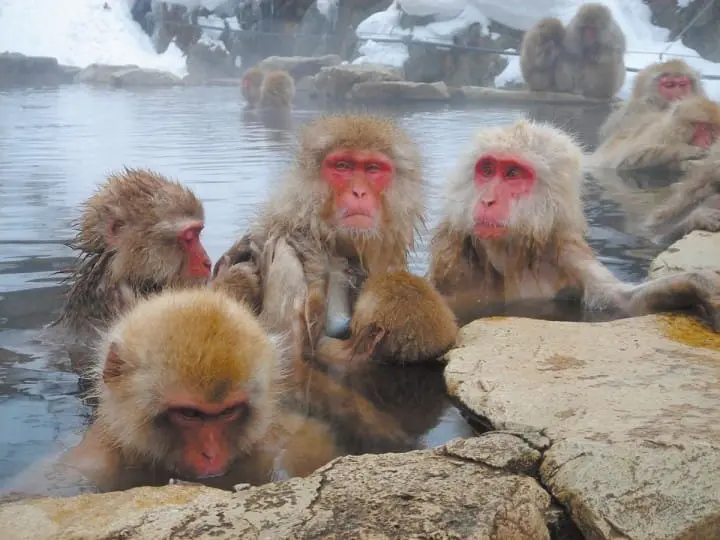
You have probably seen the famous pictures of monkeys bathing in hot springs. Shibu Onsen in Nagano is very famous for the Jigokudani Wild Monkey Park. Here you can watch the monkeys roam free and taking onsen baths.

After enjoying the sight of the monkeys bathing, how about enjoying the hot springs yourself? We don't recommend jumping in with the monkeys, though. Enjoy the excellent services of the hotels and ryokans in the area.
Out of the nine open-air baths at Shibu Onsen, eight of them can be used free of charge by the town residents and those staying at one of the inns.
If you are a Studio Ghibli fan, you might want to consider checking in at Kanaguya, a ryokan which is rumored to have served as a model for the bathhouse in "Spirited Away".
In any case, Shibu Onsen is a great place to visit thanks to its many unique sights and wonderful hot springs.
Find accommodation in Shbu Onsen on Booking.com
Hotels near Shibu Onsen Visitor Center Shibu Onsen Ryokan Association
Read also
7. Hakone, Hot Springs near Mt. Fuji

The onsen district in Hakone-Yumoto. Photo by Pixta
Hakone is renowned for its onsen and is one of the best places to experience Japan's hot spring and bath culture. Moreover, there are many excellent art museums in Hakone, making it a must-visit for those who love art and Japanese culture.
The area near Hakone-Yumoto Station, in particular, is home to many hot spring facilities and inns where visitors can take a soak in Hakone's famous springs; the surrounding natural scenery is lovely as well.
Yunessun, a one-of-a-kind hot spring theme park located further into Hakone, is also a must-visit.
Hotels near Hakone Kowakien Yunessun

Photo by Pixta
Hakone Yuryo is a well-known day spa facility that allows travelers visiting Hakone for the day to experience Japan's hot spring culture. The facility contains many different types of natural hot spring baths, both indoors and outdoors that are public, as well as private hot spring rooms that you can reserve in advance.
There is also a restaurant at the facility where guests can enjoy a hearty irori (hearth-cooked) Japanese meal to finish the day after soaking in the hot springs.
Find accommodation in Hakone on Booking.com
↑ Return to the top of article.
8. Atami Onsen near Tokyo

Photo by Pixta
Atami is a famous hot spring resort area in Shizuoka, just 50 minutes away from Tokyo by bullet train, which makes it a great destination for day trips.
The hot springs in Atami are chloride springs. With heavy salt content similar to seawater, chloride springs are particularly good for warming the body, fighting off chills, and alleviating nerve, muscle, and joint pain.

The famous Atami Fireworks launched over the bay (*1). Photo by Pixta
There are several hot spring towns in the Atami area, including Izu Yugawara Onsen and Ajiro Onsen. But the hot spring resort known as Atami Onsen is particularly famous because, in addition to excellent hot springs, it also has vibrant shopping streets (shotengai), museums such as the MOA Museum of Art, and entertainment such as fireworks. Moreover, Atami Sun Beach is just a few minutes away from the onsen quarter on foot.
*1 In autumn 2023, the Atami Fireworks will be launched in the evening from 20:20 on October 14 and December 3.
Find accommodation in Atami on Booking.com
9. Wakura Onsen

Photo by Pixta
Wakura Onsen is located in Nanao, a city in the Noto Peninsula of Ishikawa Prefecture. It is said to have a history of more than 1,200 years and is a leading hot spring resort in Japan.
The local hot spring water contains sodium and calcium and is said to be good for rheumatism and nerve pain. The town faces the Sea of Japan, and its water has a high salt content that is characteristic of a seaside onsen.

The view from Yuttari Park in Wakura Onsen. Photo by Pixta
Wakura Onsen is famous for its flavorful rice, vegetables, local sake, Noto beef, and other specialties. At Nanao Harbor and Tomiyama Harbor, yellowtail, Kano crab, rockfish, anglerfish, and other kinds of seafood can be caught in front of your eyes. The town has plenty of sushi restaurants where visitors can enjoy the flavors of the Noto Peninsula.
Find accommodation in Wakura Onsen on Booking.com
Read also
↑ Return to the top of article.
10. Kaga Onsen

The Kosoyu in Yamashiro Onsen. Photo by Pixta
Kaga Onsen is a cluster of hot spring towns near Kanazawa in Ishikawa Prefecture. Yamashiro Onsen, Yamanaka Onsen, and Katayamazu Onsen are collectively known as Kaga Onsen.
Yamashiro Onsen, in particular, is very popular among both domestic and international visitors. A historic hot spring town located just about 45 minutes away from Kanazawa, this is the ideal place to experience a slower side of Japan.
This area is famous for delicate handicrafts such as Kutani porcelain ware; a simple stroll around town is a chance to visit small shops handling these lovely Japanese items and taste exquisite local specialties.

Photo by Pixta
Bathing facilities in Kaga Onsen are often decorated with beautiful Kutani porcelain tiles or stained glass tiles, a feature that you won't encounter anywhere else.
Find accommodation in Kaga Onsen on Booking.com
Read also
11. Kinosaki Onsen in Hyogo
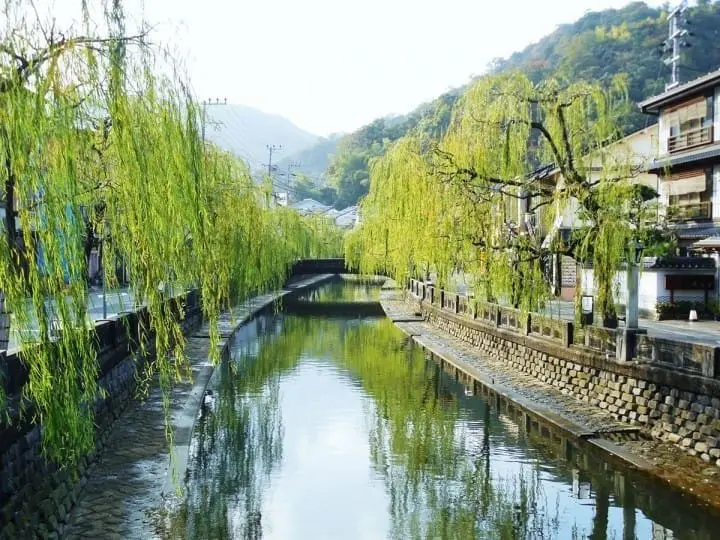
Kinosaki Onsen in Hyogo prefecture has a history dating back 1300 years and is one of the leading onsen resorts in Japan.
There are seven open-air hot springs within walking distance from one another. They offer a pass called the "Yumepa" which gives visitors unlimited one-day access to all seven hot springs. This offer is called "The Tour of the Seven Hot Springs". The pass costs 1200 yen for adults and 600 yen for children. You can purchase it at any of the participating hot springs.
This offer gives you a great variety of onsen to choose from. If you don't enjoy one of the hot springs, you can simply move to another.
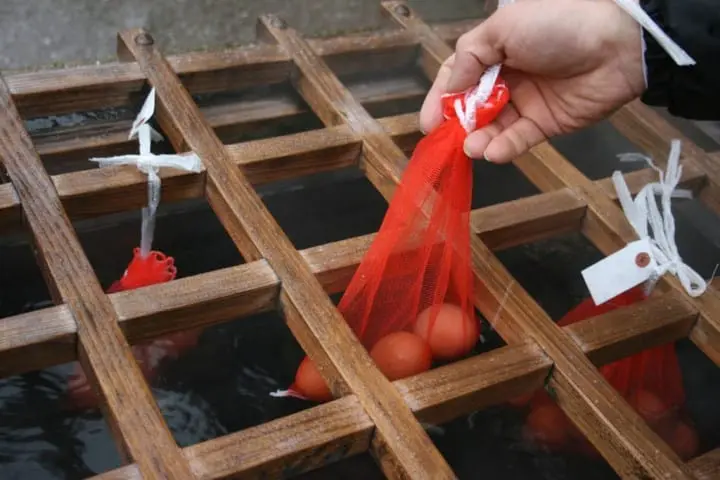
Kinosaki Onsen also offers a wide variety of onsen-related food. At the Kinosaki Gelato Cafe Chaya, you can buy eggs and boil them in the hot spring water in front of the shop.
Onsen tamago (hot spring boiled eggs) are a very popular local treat. However, the chance to boil them yourself in real hot spring water is very rare, so don't miss it out when visiting Kinosaki Onsen!
Find accommodation in Kinosaki on Booking.com
↑ Return to the top of article.
12. Arima Onsen in Hyogo

Picture from Accessing Arima Onsen, Japan's Oldest Hot Spring In Hyogo Prefecture
Arima Onsen is located in Hyogo prefecture as well. It is one of Japan's oldest onsen resorts alongside Ehime’s Dogo Onsen and Wakayama’s Shirahama Onsen.
It is a hot spring area with gushing waters. It offers golden springs and two kinds of silver springs.

The golden springs have a high content of salt and iron. As mentioned previously, iron is extremely good in treating eczema and dry skin. Salt works as a disinfectant and improves blood circulation. The mixture of both is supposed to have moisturizing and healing effects.

There are two kinds of silver springs in Arima Onsen. One consists of carbonic spring water and the other of radon spring water. They are called silver springs because their water is clear and shiny like silver. The carbonic spring water improves blood circulation and is even drinkable in some cases.
Besides being the home of some of the best hot springs in Japan, Arima Onsen is a great place to just lean back and relax.
Find accommodation in Arima Onsen on Booking.com
13. Dogo Onsen in Ehime
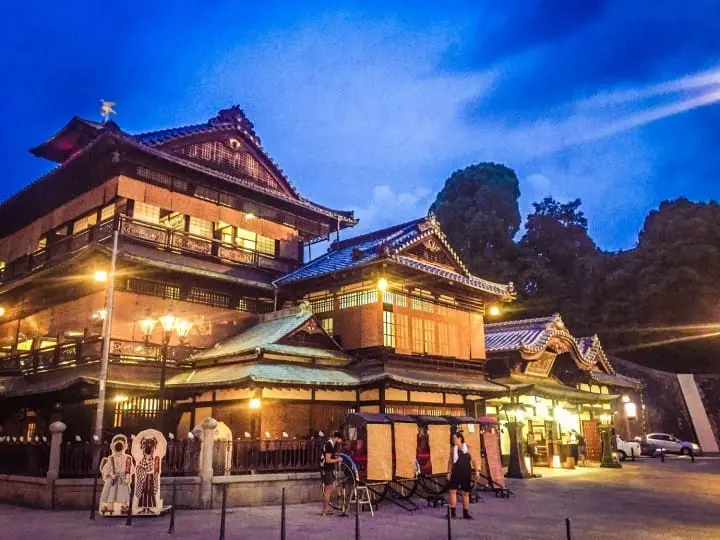
One of the most famous hot springs in Japan is Dogo Onsen, located in Ehime prefecture. It is supposed to be the oldest onsen resort in Japan, but there is really no way of telling when and where the first onsen was built. It is also famous for being another main inspiration for the bathhouse in Studio Ghibli's movie "Spirited Away".
The Dogo Onsen resort consists of two buildings, the original building "Honkan" and the newer and bigger "Tsubaki No Yu". We recommend the "Tsubaki No Yu" as it is bigger and not as busy as the main building.
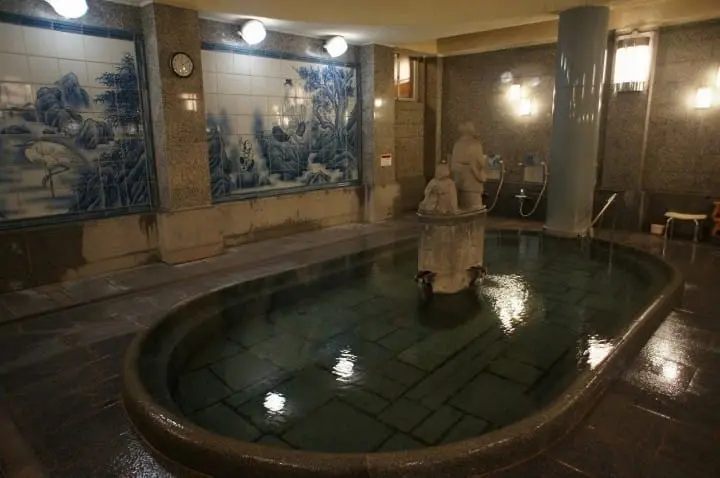
Dogo Onsen boasts Alkaline spring waters which improve skin conditions and sanitizes wounds. It is very gentle to the skin and fit for children and the elderly.
There are 29 different hot springs feeding the source of Dogo Onsen. The various spring waters are mixed and used in the bathhouses.
If you have sensitive skin or want to experience old, opulent bathhouses, we highly recommend Dogo Onsen.
Find accommodation in Dogo Onsen on Booking.com
↑ Return to the top of article.
14. Kurokawa Onsen in Kumamoto
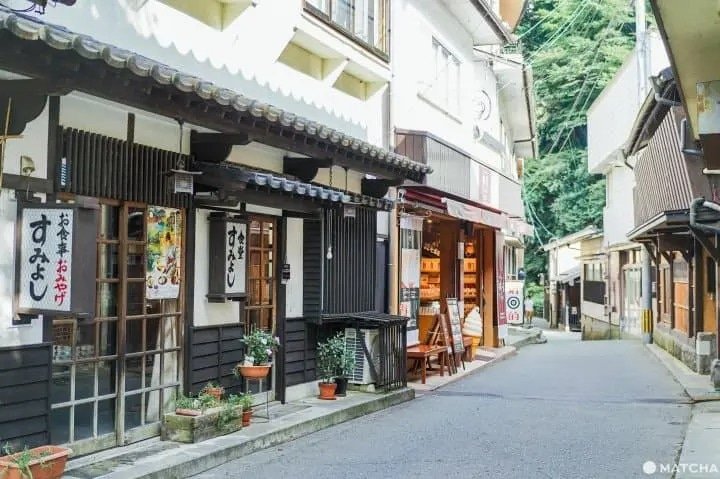
Kurokawa Onsen is a hot spring resort with over 300 years of history that can be easily reached from Fukuoka. The town is located at an altitude of 700 meters above sea level on Mount Aso in Kumamoto.
There are six main kinds of hot springs in Kurokawa Onsen: mildly acidic simple springs to relieve fatigue and stress, mildly alkaline simple springs for smooth skin, sulfur springs to detox and improve diseases caused by an unhealthy lifestyle, hydrogen carbonate springs for beautiful skin, chloride springs for heat insulation and temperature control, and sulfate springs effective in improving high blood pressure and arteriosclerosis. Each ryokan inn or day spa offer one or several of these hot springs.

Yuakari' (Photo courtesy of Kurokawa Onsen Ryokan Association)
During the winter event 'Yuakari', the streets of Kurokawa Onsen are decorated with bamboo lanterns. The event schedule is subject to change year to year, so please check with the official webpage for details.
Find accommodation in Kurokawa Onsen on Booking.com
15. Beppu Onsen in Oita
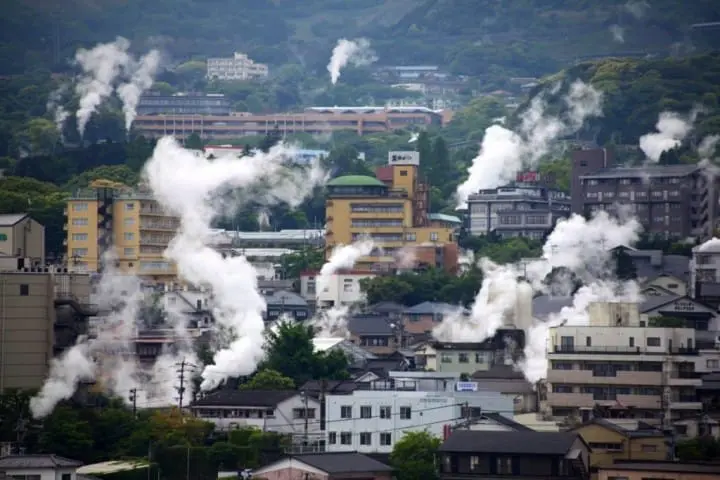
Beppu Onsen in Oita Prefecture boasts the greatest volume of hot spring water in Japan. It might look like the town is on fire but it's just the steam of the hot water rising from the ground.

The area is also famous for its "Hell Tour" - a series of eight unusual hot spring spots that seem to be out of this world. The blue one, Umi Jigoku, for example, gets its color from sulfuric acid and its temperature is 98 degrees Celsius.
This tour is worth a visit alone, but we are here for the onsen we can bathe in, right? Beppu Onsen offers a wide variety of indoor and outdoor hot springs.

In addition to normal hot baths, they also offer sand baths. You get buried in the rich soil heated up by the hot springs moving underneath the surface and relax for a few minutes. It's a great way to get rid of fatigue.
Beppu Onsen is also famous for its "steamed cuisine" (jigoku-mushi), in which vegetables and eggs are cooked using the steam of hot springs. Not only is this local specialty healthy but it also tastes excellent - the ingredients get a rich flavor from the salt found in the hot springs.
In other words, with its variety of hot spring types, Beppu Onsen is truly unique and an ideal place for a relaxing holiday. Yufuin Onsen, also located in Oita, is a charming hot spring town that is also worth visiting.
Find accommodation in Beppu on Booking.com
Read also
16. Hisamatsuyu Onsen (Nerima)
Hisamatsuyu Onsen, located in the Nerima district, is a modern and stylish onsen known for its innovative approach to the traditional bathhouse experience. The facility draws natural hot spring water from 1,500 meters underground and is celebrated for its full tattoo-friendly policy, which welcomes visitors with body art without restrictions.
What truly sets Hisamatsuyu apart is its unique projection mapping display on the ceiling, which creates a mesmerizing, ever-changing light and art show while you soak. This artistic touch, combined with the genuine natural hot spring, makes it a must-visit for those seeking a relaxing and aesthetically pleasing tattoo-friendly onsen.
17. Kosugiyu (Koenji)
Kosugiyu is a beloved public bathhouse in the vibrant and bohemian neighborhood of Koenji, and it stands out as an excellent, tattoo-friendly option that has been a community staple for over 90 years. The bathhouse has a relaxed and welcoming atmosphere, openly embracing tattooed guests, reflecting the artistic and alternative culture of the surrounding area.
Kosugiyu is famous for its distinct baths, including a unique milk bath and a jet bath, providing a variety of soaking experiences. With its long history and welcoming attitude, Kosugiyu offers an authentic and inclusive glimpse into Tokyo's local bathhouse culture.
18. Zaborin (Niseko, Hokkaido)

Photo courtesy of Booking.com
Zaborin is arguably one of the most famous and highly-acclaimed ryokan in all of Japan, located in the beautiful, snowy landscape of Hokkaido. Its reputation for providing the ultimate private onsen experience is second to none. Each of the 15 villas is a separate, self-contained unit, and every single one features both an indoor and an open-air private onsen, fed directly from a natural hot spring on the property.
The mineral-rich water is a unique gensen kakenagashi, meaning it flows freely from its source without being recirculated. Zaborin's modern and minimalist design blends seamlessly with the surrounding nature, creating a sense of serene luxury and complete seclusion, making it a dream destination for couples.
Read also
19. Ubuya (Lake Kawaguchi, Yamanashi)
Ubuya is a ryokan celebrated for its unparalleled views of Mount Fuji, which can be enjoyed directly from the private onsen in many of its rooms. Located on the shores of Lake Kawaguchi, the ryokan's design is centered around providing guests with this iconic and breathtaking vista.
The rooms with private onsen are a particular highlight for couples, as they allow for a romantic soak while gazing at Japan's most famous peak and the tranquil lake below. This combination of a private, intimate bath and one of the world's most magnificent natural sights makes Ubuya a top choice for a truly iconic and romantic Japanese onsen experience.
20. Takaragawa Onsen (Gunma)

Photo by Pixta
For couples, you can opt for a private onsen bath as shown above, offering the utmost in seclusion and intimacy. Alternatively, you can embrace the traditional, adventurous spirit of a konyoku rotenburo, a mixed open-air bath. While these shared baths have become increasingly rare over time, they remain a unique and cherished part of onsen culture, often located in remote, rustic settings.
For example, Takaragawa Onsen in Gunma is known as one of Japan's most beautiful konyoku onsens, making it a must-visit for couples. Located deep in the mountains of Gunma Prefecture, it is famous for its massive, sprawling open-air baths that are situated along a picturesque river. The four main baths are surrounded by lush greenery, providing a stunning backdrop—especially in the fall, when the leaves change color. The sheer size of the baths offers a sense of privacy even when other bathers are present. They also provide yuami-gi (yukata robes) for women, making the experience more comfortable for those who prefer a bit of shyness or modesty.
Whether you prefer the privacy of your own bath or the communal, natural beauty of a konyoku, these options provide couples with the opportunity to create unforgettable memories together.
History of Onsen in Japan
The onsen tradition is deeply woven into Japan's cultural identity, evolving from ancient, sacred grounds to modern-day escapes. Historically, these volcanic hot springs were revered as places of healing, with emperors and samurai seeking their restorative powers to mend wounds. This practice, known as tōji, was purely for medicinal purposes.
During the Edo period, onsen became more accessible, transforming into vital community hubs. Public bathhouses (sento) served as social centers, and for a time, mixed-gender bathing (konyoku) was a common custom.
Today, while traditional onsen towns still thrive, the industry has embraced luxury and privacy. Modern ryokan now offer private, in-room baths, catering to a diverse range of preferences. Despite this evolution, the timeless appeal of onsen remains the same: a unique piece of heritage that soothes both body and mind.
Relax and Enjoy a Winter Bath
Winter is the best season to explore some of Japan's hot springs. Even if you aren't so interested in the steamy hot water, just think about how relaxing it is to sit in hot water after a long walk in the snow. All your tiredness would be taken away, and you'll warm up even if it's cold outside.
Followed up by hot tea or a warm cocoa drink, there is no better way to enjoy a snowy evening in Japan. How about giving the onsen another try?
Read also
I was born and raised in Berlin, Germany and am living in Tokyo, Japan since 2008. I am native in German and English.
I am a cat-mom to three rescue cats and I have a deep love for 90s rock music, kickboxing, history, chocolate and cookie dough, anything pistachio flavored, cats and bats, dragons and vampires and all things creepy-cute.
My favorite book author is Anne Rice. My favorite band is LUNA SEA.
My most recommended Japanese movie is 'Merry Christmas, Mr. Lawrence', featuring David Bowie and Ryuichi Sakamoto.



























![[Noto Peninsula/Nanao City] 7 recommended Noto-mae sushi restaurants](https://resources.matcha-jp.com/resize/200x2000/2023/09/12-145675.webp)















































![[Northern Okinawa] 4 Recommended Cosmos Fields in Okinawa | Sunflowers and Cherry Blossoms in the Same Season!](https://resources.matcha-jp.com/resize/720x2000/2024/08/12-192028.webp)



![[Corporate Visit List] Near Kansai Airport! Discover Japan’s Technology and Business Philosophy through Industrial Tourism](https://resources.matcha-jp.com/resize/720x2000/2024/12/13-215168.webp)